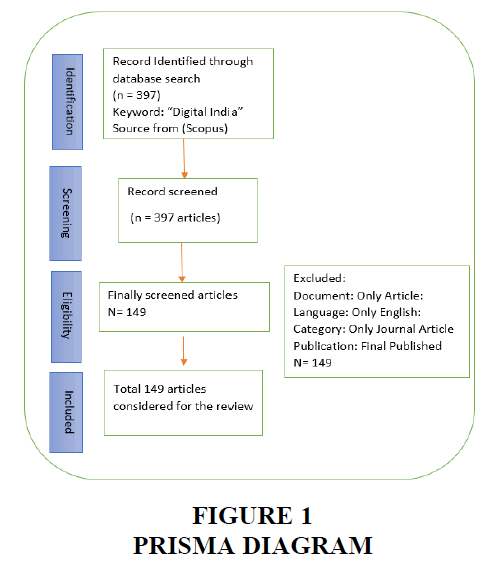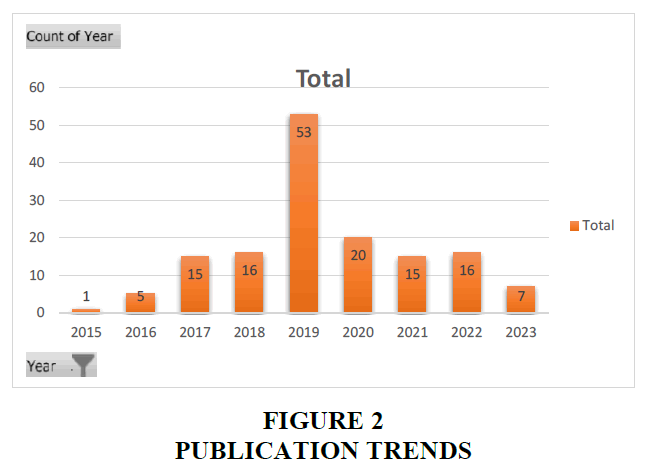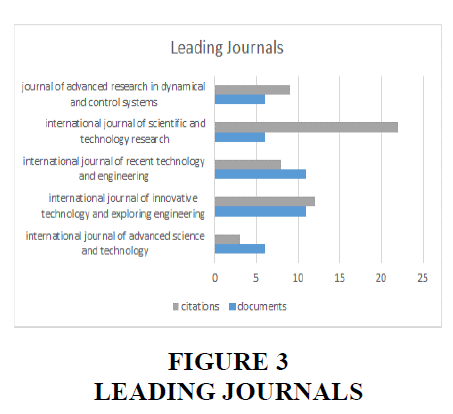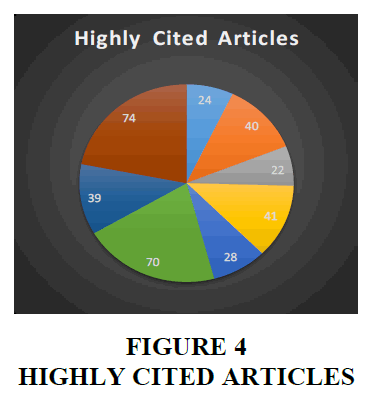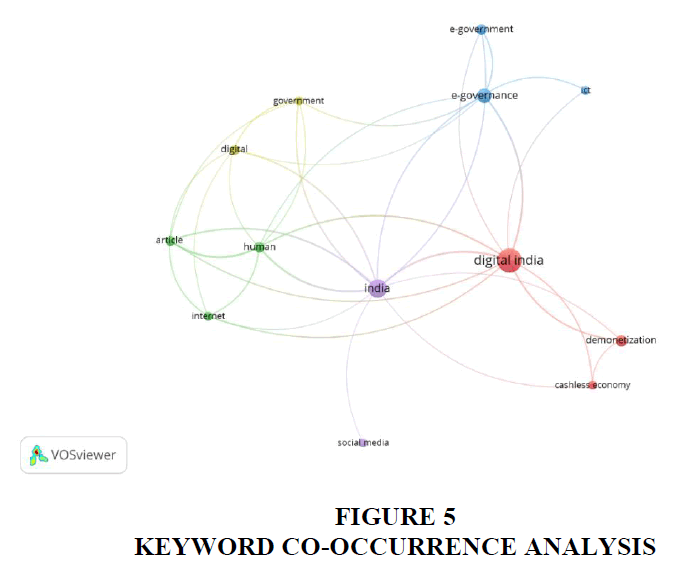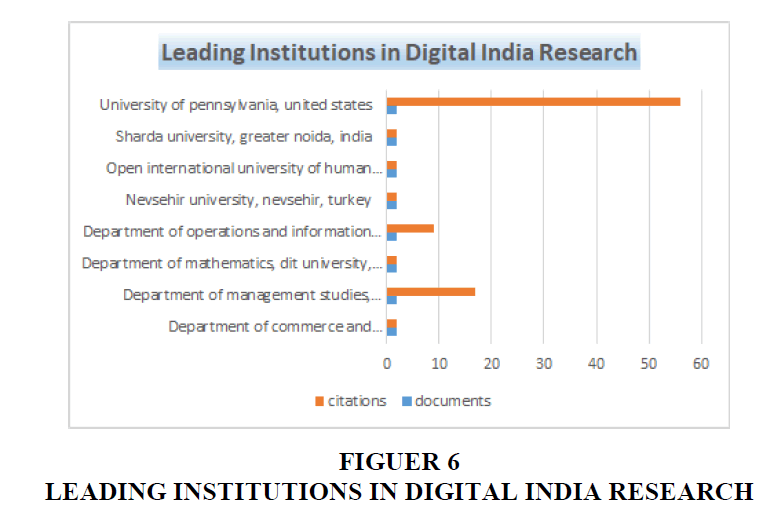Research Article: 2024 Vol: 28 Issue: 2S
Transforming India into a Digital Powerhouse - A Systematic Review and Bibliometric Analysis of Digital India
Prashant Pareek, Shanti Business School, Ahmedabad, Gujarat, India
Malay Patel, Sandip University, Nashik, Maharashtra, India
Nirmit Kansara, Shanti Business School, Ahmedabad, Gujarat, India
Citation Information: Pareek, P., Patel, M., & Kansara, N. (2024). Transforming india into a digital powerhouse – a systematic review and bibliometric analysis of digital India. Academy of Marketing Studies Journal, 28(S2), 1-10.
Abstract
Digital India, a transformative initiative launched by the Government of India, aims to establish a digitally empowered society and knowledge economy. This paper presents a comprehensive systematic literature review and bibliometric analysis of research articles on Digital India. By analysing 149 journal articles published between 2015 and 2023, we provide valuable insights into the research landscape, identify emerging trends, and highlight key research themes. Our findings reveal significant publication growth, with a surge in articles during 2019 and 2020. We identify leading journals that have contributed to the discourse on Digital India, along with highly cited articles and productive authors. Furthermore, we conduct keyword co-occurrence analysis and highlight the prominent themes, such as e-governance, digital literacy, and cyber security. The results of this study contribute to the existing literature, provide guidance for future research endeavours, and support evidence-based policy-making in the domain of Digital India.
Keywords
Digital India, Systematic Review, Bibliometric Analysis, Technology Adoption.
Introduction
Digital India is an ambitious initiative launched by the Government of India in 2015 with the aim of transforming the country into a digitally empowered society and knowledge economy (Padmaja, & Venkata Durga Rao, 2019). It encompasses various programs and policies designed to harness the power of information and communication technologies (ICTs) to bridge the digital divide, improve governance, and enhance the delivery of public services (Aggarwal, et al. 2021). Since its inception, Digital India has received significant attention from researchers and policymakers, leading to a growing body of scholarly literature that explores its various aspects and impacts (Baishya, 2022).
Systematic literature reviews (SLRs) are widely recognized as valuable research methodologies for synthesizing existing knowledge on a specific topic (Agarwal, & Agarwal, 2023). By systematically identifying, evaluating, and analysing relevant scholarly articles, SLRs provide a comprehensive overview of the state of research and identify research gaps and trends. In the context of Digital India, conducting a systematic literature review can offer insights into the research landscape, identify key research themes, and inform future research directions (De, & Shukla, 2020).
Several studies have already conducted systematic literature reviews on Digital India and its sub-domains (Nedungadi, et al. 2018). For example, Singh et al. (2021) conducted a systematic review focusing on the role of e-governance in Digital India and identified key challenges and opportunities in implementing digital governance initiatives. Similarly, (Sharma and Saxena, 2020) performed a systematic review to understand the impact of Digital India on the banking sector, highlighting the benefits and challenges associated with digital financial services (Ghosh, D. 2021).
In addition to conducting a systematic literature review, bibliometric analysis can provide a quantitative assessment of the scholarly output related to Digital India (Iyengar, et al. 2017). Bibliometric involves the analysis of publication patterns, citation counts, authorship trends, and other bibliographic data to assess the impact, productivity, and collaboration within a specific research field. By employing bibliometric techniques, researchers can gain a deeper understanding of the publication trends, influential authors and institutions, and interdisciplinary collaborations in the field of Digital India (Madhava Priya, et al. 2019). Several studies have employed bibliometric analysis to examine the research landscape of Digital India. For instance, Bhatia et al. (2020) conducted a bibliometric analysis of research articles related to Digital India published between 2014 and 2019. Their study revealed an increasing trend in the publication output, with prominent research themes such as e-governance, digital literacy, and cyber security. Furthermore, the study identified notable institutions and authors contributing to the field. The purpose of this paper is to present a systematic literature review and bibliometric analysis of research articles related to Digital India. By synthesizing the existing knowledge and assessing the scholarly output, this study aims to provide a comprehensive overview of the research landscape, identify research gaps, and highlight emerging trends in the field. The findings of this study will not only contribute to the existing literature but also guide future research endeavours on Digital India.
Methodology
Publications related to Digital India were found using the Scopus database. Scopus is considered as comprehensive repository of peer-reviewed research in social science. We used the following search query: TITLE-ABS-KEY ( "Digital India" ) AND ( LIMIT-TO ( DOCTYPE , "ar" ) ) AND ( LIMIT-TO ( LANGUAGE , "English”) ) AND ( LIMIT-TO ( SRCTYPE , "j" ) ) AND ( LIMIT-TO ( PUBSTAGE , "final" ) ).Only journals articles published in English language during the years 2015 to 2023 were chosen for the study. After filtration, total 149 journal articles were considered to conduct the analysis. Only articles which were finally published were considered for this review. Figure 1 presents the prisma diagram, which consist of information on screening, eligibility and inclusion exclusion criteria.
149 articles were analysed using bibliometric techniques, bibliometric analysis is quantitative research method used to evaluate and analyse scientific literature within a specific field. It involves examining various bibliographic characteristic such as publication patterns, citations count, author collaboration, and journal impact factors. This approach provides insights into the growth and impact of research, identify influential authors, institutions, and highlights emerging trends. It is widely used to assess the productivity and impact of researchers, identify research gap and informed policy decisions. By utilizing bibliometric analysis, researcher can gain a comprehensive understating of the knowledge landscape, collaboration networks, and research trends within a specific field. VOSviewer software was used to conduct keyword co-occurrence analysis. VOSviewer takes bibliographic data as input and provides network graphs output.
The below mentioned were the objectives of the study.
Primary Objective
To conduct systematic literature review and bibliometric analyses related to Digital India.
Secondary Objectives
1. To understand the trend of publication in the field of Digital India.
2. To identify leading journals, which have published, articles related to Digital India.
3. To identify highly cited articles related to Digital India.
4. To identify the most productive authors in Digital India.
5. To identify leading institutions in Digital India research.
Results and Discussion
Publication Trends
Table 1 presents the publication trend from the year 2015 to 2023. Digital India Started in the year 2015, till 2023 total no of 149 articles got published as per the Scopus database. In the year 2019 highest no of articles got published, in the year 2020, 20 articles were published in the journals index in the Scopus database. In the year 2023, so far 7 articles have been published as per the data extracted from the Scopus database. Figure 2 is the graphical representation of table 1. It also indicates that 2019, and 2020 were the years when highest no of articles related to digital India was published.
Leading Journals
Table 2 presents the top five journals in terms of publishing highest no of articles in the domain of Digital India from 2015 to 2023. “International Journal of innovative technology and exploring engineering”, and “International Journal of recent technology and Engineering” in these two journals highest no of articles were published. The articles published in “International Journal of Scientific and technology research” had received highest no of citations that is 22. Out of the total 148 articles published related to Digital India from 2015 to 2023, 40 articles had been published in top five journals. All the articles published in above listed top five journals had received total 54 citations. Figure 3 is the graphical representation of table 3. It also indicates the citations and no of documents Figure 4.
Table 3 presents the details of highly cited articles in the domain of Digital India. "IoT-based agriculture as a cloud and big data service: The beginning of digital India (74 citations)” got the highest citation. The second highly cited articles is “Towards an inclusive digital literacy framework for Digital India (70 citations)”. The third highly cited articles is “Analysing the start-up ecosystem of India: A Twitter analytics perspective (41 citations)”. The fourth highly cited article is “Jio sparks Disruption 2.0: infrastructural imaginaries and platform ecosystems in Digital India. (40 citations).” The above listed eight articles had received total 338 citations. Figure 5 represents the pie chart of highly cited articles, in this pie chart the number of citation received by each article is presented in different colours.
The Most Productive Authors in Digital India
Table 4 presents the most productive authors in terms of citation received in the domain of Digital India. “Gill s.s.; buyya r.; Chana I.” got the highest citation for their article (74 Citations). Nedungadi et al. (2018) got the second highest citations for their article (70 citations). “Singh s.; Chauhan a.; dhir s.” got the third highest citations for their article (41 citations). “Mukherjee r.” got the fourth citations for their article (40 citations). “Saxena (2018).” had published two articles, which received 27 citations.
Keyword Co-Occurrence Analysis
We have created keyword co-occurrence map which is presented in figure 5 for its development we had restricted the minimum no of keyword occurrences to five. Vosviewer had identified 13 keywords that meet the threshold the five most occurring keywords from table 5 were Digital India (36), India (22), E-governance (14), Demonetization (8), E-government (7) Ramya Reddy & Rakesh (2019).
As can be observed from figure 5 that keywords were divided into three clusters Red, Green, and Blue colour. The keywords in red cluster were Digital India, Demonetization, Cashless economy. The keywords in Green cluster were article, human, internet. The keyword in blue cluster were e-government, e-governance, ict.
Leading Institutions in Digital India Research
Table 6 presents the details of Institutions which have significantly contributed in research related to Digital India. “University of Pennsylvania” (United States) had published two articles which had received 56 citations. “Department of management studies, Indian institute of technology” (new Delhi) had also produced two articles which had received 17citations. “Department of operations and information management, Aston business school, Aston university, Birmingham, (United Kingdom) had published two articles which had received 9 citations. Aston university, Nevsehir university, Open international university of human development, and University of Pennsylvania are foreign universities which have published articles related to Digital India. Figure 6 represent the bar chart of leading institutions those who have contributed in the domain of Digital India. The orange colour line in the bar chart indicate the citation received and blue colour line indicates document produced.
Conclusion
Based on the data from the Scopus database in this review paper, we conducted a Systematic review and Bibliometric analysis of 149 Journal articles published in the period from 2015 to 2023. The articles considered for this study were all in English language and indexed in the Scopus database. The objectives of this paper are mentioned below:
1. To understand the trend of publication in the field of Digital India.
2. To identify leading journals, which have published, articles related to Digital India.
3. To identify highly cited articles related to Digital India.
4. To identify the most productive authors in Digital India.
5. To identify leading institutions in Digital India research.
Publication trend gives insights into the number of papers published in various Scopus-indexed journals from 2015 to 2023. Digital India started in the year 2015 and until 2023 total no of 149 articles was published as per the Scopus database. In the year 2019, the highest no of articles were published. The top five leading journals with the highest citations are the International Journal of advanced science and Technology, the International Journal of innovative technology and exploring engineering, International Journal of recent technology and Engineering, International Journal of Scientific and technology research, and Journal of advanced research in Dynamical and control systems. The top two highly cited articles in the domain of Digital India are "IoT-based agriculture as a cloud and big data service: The Beginning of digital India (74 citations)” got the highest citation. The second highly cited articles is “Towards an inclusive digital literacy framework for Digital India (70 citations)”. The leading institutions in Digital India research are University of Pennsylvania and Indian Institute of Technology – Delhi. As no study can be free of limitations, this study too has certain limitations like we have used the data from Scopus database only, other databases like web of science, Science direct and proquest etc. also consist research articles on Digital India which we have not taken under purview for this study. The document type which has been used for this review are journal articles only, other types of documents like conference papers, book chapters, opinion articles etc. have not been considered. Other limitation of this study is the Authors’ affiliation, the affiliations of authors’ mentioned in the study may change, therefore it may happen that one author writing multiple papers but affiliated with different institution every time. Nevertheless this review is an attempt to understand the mapping of literature on Digital India since the year it came into being, this article can be a good source of reference for research scholars to understand the literature produced in the domain of digital India so far.
Future Research Direction
Building on the findings of this systematic literature review and bibliometric analysis, several promising avenues for future research on Digital India emerge. These directions aim to expand the knowledge base, address research gaps, and inform policy interventions.
1. Impact Assessment: Future studies should focus on assessing the impact of Digital India initiatives on various stakeholders, including citizens, businesses, and government entities. Quantitative and qualitative analyses can evaluate the effectiveness of digital interventions in improving service delivery, promoting inclusion, and driving economic growth.
2. User Perspectives: Understanding the experiences and perceptions of users is crucial for designing user-centric digital services. Future research should explore user perspectives on Digital India initiatives, examining factors influencing user adoption, usage patterns, satisfaction levels, and challenges faced by different user groups.
3. Digital Divide: Despite efforts to bridge the digital divide, disparities in digital access and skills persist. Future research should investigate the factors contributing to the digital divide and propose strategies to ensure equal access, digital literacy, and digital inclusion, particularly among marginalized communities.
4. Data Privacy and Security: As digital technologies proliferate, ensuring data privacy and cybersecurity becomes increasingly critical. Future research should delve into the challenges and implications of data privacy, cybersecurity risks, and regulatory frameworks required to protect users' digital rights in the context of Digital India.
5. Technology Adoption and Infrastructure: Exploring the factors influencing technology adoption and evaluating the readiness of infrastructure is vital for successful implementation of Digital India initiatives. Future studies should examine the barriers and enablers of technology adoption, assess the quality of digital infrastructure, and propose strategies for enhancing technological readiness.
6. Socio-economic Impacts: Digital transformation has far-reaching socio-economic implications. Future research should investigate the impact of Digital India on employment patterns, income distribution, education, healthcare, and social welfare. Understanding these impacts will help policymakers design inclusive and equitable digital policies.
7. Evaluation of Policies and Programs: Continuous evaluation of Digital India policies and programs is essential to assess their effectiveness, identify areas of improvement, and ensure accountability. Future research should focus on rigorous evaluations using both quantitative and qualitative methods to provide evidence-based insights for policymakers.
By pursuing these research directions, scholars can contribute to the evolving discourse on Digital India, facilitate evidence-based decision-making, and support the realization of the initiative's vision of a digitally empowered nation.
References
Agarwal, Y., & Agarwal, A. (2023). Analysis of Union Budget 2023-24: India@100 enduring Transparency, Accountability and Sustainability. Finance India, 37(1), 23–38.
Aggarwal, K., Malik, S., Mishra, D. K., & Paul, D. (2021). Moving from Cash to Cashless Economy: Toward Digital India. Journal of Asian Finance, Economics and Business, 8(4), 43–54.
Indexed at, Google Scholar, Cross Ref
Bhatia, S., Agarwal, N., & Kumar, A. (2020). Bibliometric analysis of research articles on Digital India (2014–2019). DESIDOC Journal of Library & Information Technology, 40(3), 166-174.
Baishya, A. K. (2022). Violent spectating: Hindutva music and audio-visualizations of hate and terror in Digital India. Communication and Critical/ Cultural Studies, 19(3), 289–309. Scopus.
Indexed at, Google Scholar, Cross Ref
De, S. J., & Shukla, R. (2020). Privacy policies of e-governance initiatives: Evidence from India. Journal of Public Affairs, 20(4).
Indexed at, Google Scholar, Cross Ref
Ghosh, D. (2021). The commercialization of bias in cashless India. Telecommunications Policy, 45(5).
Indexed at, Google Scholar, Cross Ref
Iyengar, V., Pillai, S., Pednekar, J., & Abhyankar, M. (2017). Enablers for digital empowerment in technology using interpretive structural modeling (ISM) and MICMAC analysis. International Journal of Applied Business and Economic Research, 15(2), 161–176.
Madhava Priya, D., Prashanth, J., & Indira, A. (2019). Sustainability of small merchants through digital technologies. Prabandhan: Indian Journal of Management, 12(1), 8–20.
Nedungadi, P. P., Menon, R., Gutjahr, G., Erickson, L., & Raman, R. (2018). Towards an inclusive digital literacy framework for digital India. Education and Training, 60(6), 516–528. Scopus.
Indexed at, Google Scholar, Cross Ref
Padmaja, C. H., & Venkata Durga Rao, P. (2019). The rise and growth of digital payments in India. International Journal of Innovative Technology and Exploring Engineering, 8(12), 359–363.
Ramya Reddy, P., & Rakesh, C. (2019). Challenges in adoption of new technologies in banking sector – A study with reference to selected private banks, Bengaluru. International Journal of Management, 10(4), 173–181.
Indexed at, Google Scholar, Cross Ref
Saxena, S. (2018). Perception of corruption in e-government services post-launch of “Digital India”: Role of demographic variables. Digital Policy, Regulation and Governance, 20(2), 163–177. Scopus.
Indexed at, Google Scholar, Cross Ref
Sharma, R., & Saxena, S. (2020). Digital India: A systematic literature review of banking sector. International Journal of Information Management, 55, 102145.
Singh, H., Gahlot, N., & Sinha, R. (2021). Role of e-governance in Digital India: A systematic review. International Journal of Advanced Computer Science and Applications, 12(3),
Received: 22-Jul-2023, Manuscript No. AMSJ-23-13816; Editor assigned: 24-Jul-2023, PreQC No. AMSJ-23-13816(PQ); Reviewed: 27- Oct-2023, QC No. AMSJ-23-13816; Revised: 03-Nov-2023, Manuscript No. AMSJ-23-13816(R); Published: 06-Dec-2023
